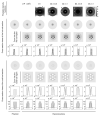Non-Uniform Object-Space Pixelation (NUOP) for Penalized Maximum-Likelihood Image Reconstruction for a Single Photon Emission Microscope System
- PMID: 28255178
- PMCID: PMC5330327
- DOI: 10.1109/TNS.2009.2024677
Non-Uniform Object-Space Pixelation (NUOP) for Penalized Maximum-Likelihood Image Reconstruction for a Single Photon Emission Microscope System
Abstract
This paper presents a non-uniform object-space pixelation (NUOP) approach for image reconstruction using the penalized maximum likelihood methods. This method was developed for use with a single photon emission microscope (SPEM) system that offers an ultrahigh spatial resolution for a targeted local region inside mouse brain. In this approach, the object-space is divided with non-uniform pixel sizes, which are chosen adaptively based on object-dependent criteria. These include (a) some known characteristics of a target-region, (b) the associated Fisher Information that measures the weighted correlation between the responses of the system to gamma ray emissions occurred at different spatial locations, and (c) the linear distance from a given location to the target-region. In order to quantify the impact of this non-uniform pixelation approach on image quality, we used the Modified Uniform Cramer-Rao bound (MUCRB) to evaluate the local resolution-variance and bias-variance tradeoffs achievable with different pixelation strategies. As demonstrated in this paper, an efficient object-space pixelation could improve the speed of computation by 1-2 orders of magnitude, whilst maintaining an excellent reconstruction for the target-region. This improvement is crucial for making the SPEM system a practical imaging tool for mouse brain studies. The proposed method also allows rapid computation of the first and second order statistics of reconstructed images using analytical approximations, which is the key for the evaluation of several analytical system performance indices for system design and optimization.
Keywords: Non-uniform object-space pixelation (NUOP); penalized maximum-likelihood; single-photon emission microscope (SPEM).
Figures







Similar articles
-
Adaptive Angular Sampling for SPECT Imaging.IEEE Trans Nucl Sci. 2011 Oct;58(5):2205-2218. doi: 10.1109/TNS.2011.2164935. Epub 2011 Oct 3. IEEE Trans Nucl Sci. 2011. PMID: 27867212 Free PMC article.
-
Evaluation of Fisher Information Matrix-Based Methods for Fast Assessment of Image Quality in Pinhole SPECT.IEEE Trans Med Imaging. 2015 Sep;34(9):1830-42. doi: 10.1109/TMI.2015.2410342. Epub 2015 Mar 5. IEEE Trans Med Imaging. 2015. PMID: 25769150
-
A Vector Uniform Cramer-Rao Bound for SPECT System Design.IEEE Trans Nucl Sci. 2009 Feb 1;56(1):81-90. doi: 10.1109/TNS.2008.2006609. Epub 2009 Feb 10. IEEE Trans Nucl Sci. 2009. PMID: 28260809 Free PMC article.
-
Compensation for nonuniform resolution using penalized-likelihood reconstruction in space-variant imaging systems.IEEE Trans Med Imaging. 2004 Mar;23(3):269-84. doi: 10.1109/TMI.2003.823063. IEEE Trans Med Imaging. 2004. PMID: 15027520
-
4D image reconstruction for emission tomography.Phys Med Biol. 2014 Nov 21;59(22):R371-418. doi: 10.1088/0031-9155/59/22/R371. Epub 2014 Oct 31. Phys Med Biol. 2014. PMID: 25361380 Review.
Cited by
-
Evaluation of imaging systems using the posterior variance of emission counts.IEEE Trans Med Imaging. 2013 Oct;32(10):1829-39. doi: 10.1109/TMI.2013.2265886. Epub 2013 Jun 3. IEEE Trans Med Imaging. 2013. PMID: 23744672 Free PMC article.
-
Adaptive SPECT imaging with crossed-slit apertures.Proc SPIE Int Soc Opt Eng. 2014 Aug 17;9214:92140E. doi: 10.1117/12.2066188. Proc SPIE Int Soc Opt Eng. 2014. PMID: 26190884 Free PMC article.
-
Adaptive Angular Sampling for SPECT Imaging.IEEE Trans Nucl Sci. 2011 Oct;58(5):2205-2218. doi: 10.1109/TNS.2011.2164935. Epub 2011 Oct 3. IEEE Trans Nucl Sci. 2011. PMID: 27867212 Free PMC article.
-
Optimization of an Adaptive SPECT System with the Scanning Linear Estimator.IEEE Trans Radiat Plasma Med Sci. 2017 Sep;1(5):435-443. doi: 10.1109/TRPMS.2017.2715041. Epub 2017 Jun 13. IEEE Trans Radiat Plasma Med Sci. 2017. PMID: 29276799 Free PMC article.
-
X-ray Fluorescence Emission Tomography (XFET) with Novel Imaging Geometries - A Monte Carlo Study.IEEE Trans Nucl Sci. 2011 Dec;58(6):3359-3369. doi: 10.1109/TNS.2011.2167632. IEEE Trans Nucl Sci. 2011. PMID: 22228913 Free PMC article.
References
-
- Cherry SR. In vivo molecular and genomic imaging: New challenges for imaging physics. Phys. Med. Biol. 2004;49:R13–R48. - PubMed
-
- Peterson TE, Wilson DW, Barrett HH. Application of silicon strip detectors to small-animal imaging. Nucl. Instr. Methods. 2003;505:608–611.
-
- Accorsi R, Autiero M, Celentano L, Chmeissani M, Curion AS, Frallicciardi P, Laccetti P, Lanza RC, Lauria A, Maiorino M, Marotta M, Mettivier G, Montesi MC, Riccio P, Roberti G, Russo P. MediSPECT: Single photon emission computed tomography system for small field of view small animal imaging based on a cdte hybrid pixel detector. Nucl. Instr. Methods. 2007;571:44–47.
-
- Beekman FJ, Vastenhouw B. Design and simulation of a high-resolution stationary SPECT system for small animals. Phys. Med. Biol. 2004;49:4579–4592. - PubMed
Grants and funding
LinkOut - more resources
Full Text Sources
Research Materials
